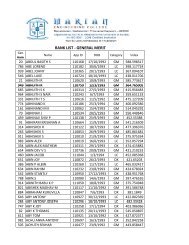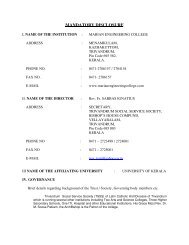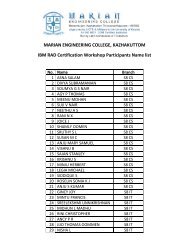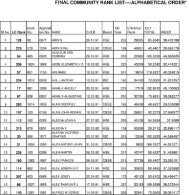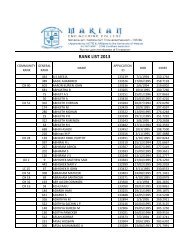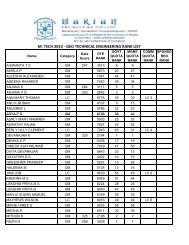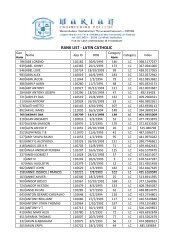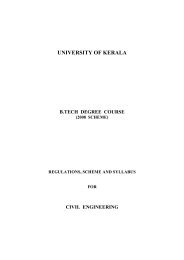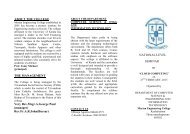UNIVERSITY OF KERALA - Marian Engineering College
UNIVERSITY OF KERALA - Marian Engineering College
UNIVERSITY OF KERALA - Marian Engineering College
Create successful ePaper yourself
Turn your PDF publications into a flip-book with our unique Google optimized e-Paper software.
B.Tech Comp. Sc. & Engg., University of Kerala 88<br />
08.806 (5) BIOINFORMATICS (ELECTIVE IV) 3 – 1 – 0<br />
Module I (17 hours)<br />
Introduction to Life Sciences: Levels of organization in nature: atom, molecule, organelle, cell, tissue, organ,<br />
organ system; Unicellular and multicellular organisms; Branches of Biology - Cell Biology - Cell as the<br />
structural and functional unit of life - Structural components of cell - Types of cells - Prokaryotic, Eukaryotic,<br />
Animal and Plant cell; Important Biomolecules- Nuclei acids, proteins, enzymes.<br />
Central Dogma: DNA, RNA and Protein; Chromosome, Genome, Genes, Gene Loci, Gene Sequencing –<br />
Short gun and Contig approach; Restriction Enzyme, restriction sites, DNA copying/amplification, PCR and<br />
Electrophoresis.<br />
Module II (18 hours)<br />
Genomics & Proteomics: String view of DNA, Reading Frames (+1, +2, +3, -1, -2, -3), Open reading frame,<br />
codon, genetic code, transcription & translation- mRNA, sense and anti-sense strands, rRNA, tRNA,<br />
upstream and downstream, genomic DNA, complimentary DNA, introns and exons, alternative spicing, junk<br />
DNA, Sequence databases- GenBank, EMBL and DDBJ- concepts of similarity- homologous- orthologous<br />
and paralogous sequences, FASTA file format.<br />
Sequence alignments- need for alignment - local and global alignments – pair-wise and multiple – PAM and<br />
BLOSSUM matrices – Needleman–Wunch and Smith-Waterman algorithms – Study on BLAST results. Gene<br />
structure – typical prokaryotic and eukaryotic gene structures – Single Nucleotide Polymorphisms (SNPs);<br />
Concepts of Phylogenetics, Distance based methods to draw phylogenetic trees – UPGMA and NJ algorithm.<br />
Study of ClustalW/ClustalX, Phylip and NJ Plot software.<br />
Proteome and proteomics – proteins as workhorse molecules of life; protein separation using 2D gel<br />
electrophoresis; Study on amino acids and four levels of protein structure – Protein databases – PDB, Uniprot<br />
Module III (17 hours)<br />
Basics of Computer Aided Drug Design (CADD), Microarray Bioinformatics, Synthetic Biology and Systems<br />
Biology. Soft computing methods in Bioinformatics – Basics of Hidden Markov Models, Artificial Neural<br />
Networks, Genetic Algorithms and Ant Colony Optimization.<br />
Text Books:<br />
1. Essential Biology (Abridged) Campbell, Cambridge<br />
2. Fundamental Concepts of Bioinformatics – D. E. Krane and M. L. Raymer, Pearson education<br />
Reference Books:<br />
1. Bioinformatics: Sequence & Genome Analysis – D. Mount, Cold Spring Harbor press, USA (Indian edition)<br />
2. Microarray Bioinformatics – D. Stekel, Cambridge University Press (Indian Edition)<br />
3. Computer Aided Drug Design: Methods and Applications – (Edited) T. J Perun, C. L Propst, Marcel Dekker.<br />
4. Systems Biology & Synthetic Biology – Pengcheng Fu and Syen Panke, Wiley.<br />
5. www. Wikipedia – Soft computing methods (refer study materials for)<br />
Internal Continuous Assessment (Maximum Marks-50)<br />
25 Marks - Tests (minimum 2)<br />
15 Marks - Assignments (minimum 3) such as home work, problem solving, literature survey, seminar,<br />
term-project, software exercises, etc.<br />
10 Marks - Regularity in the class<br />
University Examination Pattern<br />
PART A: Short answer questions 10 x 4 marks=40 marks<br />
All questions are compulsory. There should be at least three questions<br />
from each module and not more than four questions from any module.<br />
PART B: Descriptive/Analytical/Problem solving questions 3 x 20 marks=60 marks<br />
Candidates have to answer one question out of two or two questions<br />
out of four from each module.<br />
Maximum Total Marks: 100



